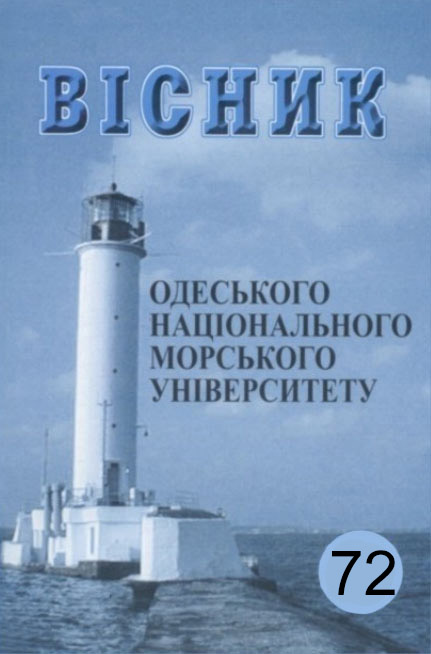Algorithm of step-by-stage optimization of ship structures according to the criteria of reliability and economy
Main Article Content
Abstract
The issues of rational design of structures and reducing their material consumption with an optimal margin of reliability have never lost their relevance. In the conditions of real design of construction, ship, and aircraft structures, the designer most often has to reckon with not one, but several usually contradictory criteria and pursue several extreme goals. In such cases, the problem of optimal design is a problem of multicriteria optimization. The optimal design of ship structures is a technical and economic problem for which the minimum weight (or cost) is not the only sign of optimality. In this work, the task of designing a structure of minimum weight (or cost) with an optimal margin of reliability, which corresponds to the minimum total costs for manufacturing and operation during the established service life, is set. As optimization criteria, the minimum average expected total costs are considered, taking into account the possible damage from destruction and the minimum weight of the structure, while observing the restrictions on stress, stiffness, as well as the limitations of structural and technological parameters. The algorithm for the step-by-step optimization of ship structures is presented on the example of the optimization of the load-bearing structures of the twin deck hatch cover of a dry cargo ship, which revealed low reliability during operation. To determine the optimal design parameters, a random search algorithm was used in combination with the finite element method (FEM). The design of the main stiffener of the hatch cover obtained as a result of solving the optimization problem, despite a slight increase in mass, nevertheless fully meets the requirements of optimal reliability and economy. With the help of the proposed algorithm, the task of designing a structure of minimum weight with an optimal level of reliability, which corresponds to the minimum total costs for manufacturing and operation, is fundamentally solved. The technical and economic approach can be practically implemented in the design and modernization of ship structures, provided that statistical information is collected and systematized about the load, materials, costs of manufacture and repair, as well as the economic consequences of structural failures.
Article Details
References
2. Pochtman Yu.M., Gerasimov E.N., Skalozub V.V. Multicriteria optimization of structures. Kyiv, 1984. 134 p.
3. Skalozub V.V. Multicriteria optimization of plates and shells in conditions of incomplete initial information: Abstract of the dissertation of Ph.D. tech. Sci. Dnepropetrovsk, 1982. 21 p.
4. Baranenko V.O. Multi-criteria problems of SHSS synthesis and dynamic programming // Bulletin of PDABiA: Scientific and informational bulletin. Dnipropetrovsk, 2000. No. 10. P. 4-12.
5. Zienkiewicz О. C., Cheung Y. K. The finite element method in structural and continuum mechanics. London, 1967. 268 р.
6. Zienkiewicz O. C. The Finite Element Method in Engineering Science. 53: McGraw-Hill, 1971. 521 p.
7. Nemchinov Yu.I. Calculation of three-dimensional structures (finite element method). K.: Budivelnik, 1980. 232 p.
8. Sakharov A.S., Kislookiy V.N. The method of finite elements in the mechanics of solid bodies. Kyiv: Higher School, 1982. 478 p.
9. Klovanich S.F. Finite element method in non-linear problems of engineering mechanics. Library of the journal «World of geotechnics», 9th edition. Z.: OOO IPO Zaporozhye, 2009. 400 p.
10. Grinev V.B., Filippov A.P. Optimization of structural elements according to mechanical characteristics. Kiev: Naukova dumka, 1975. 294 p.
11. Beiko I.V., Bublyk B.N., Zinko P.N. Methods and algorithms for solving optimization problems. K.: Higher School, 1983. 511 p.
12. Ovchinnikov I.G., Pochtman Yu.M. Thin-walled structures under conditions of corrosive wear: calculation and optimization. Dnipropetrovsk: DSU,1995.192 p.
13. Pochtman Yu.M. Finite element method in problems of optimal design of structures under the influence of aggressive environments. // Theoretical Foundations in Civil Engineering. 1996. vol. 1. R. 220-224.
14. Pochtman Yu.M., Shulga S.A. Application of the theory of planning extreme experiments to the optimal design of composite shells. In the book: Hydroaeromechanics and elasticity theory. Dnepropetrovsk: DSU, 1982, pp. 140-145. (Collection of scientific works, issue 29).
15. Filatov G.V. Optimal design of structures by random search methods. Dnipropetrovsk: UDHTU, 2003. 432 p.
16. Skalozub V.V. Parameterization of problems of vector optimization of structures // Problems of computational mechanics and strength of structures: Collection. of science works Dnipropetrovsk. 1997. T.2. P. 92-98.
17. Friedman M.M. Conceptual approaches in the optimal design of structures operating in extreme conditions // Resistance of materials and theory of structures. 2002. No. 70. P. 158-175.
18. Gellatly R. A., Gallagher R. H. A procedure for automated minimum weight desig n. Part I. Theoret. Basis. Aeron. Quart. 1966. Vol. 7. Iss. 7. Р. 63–66.
19. Arai M., Shimizu T. Optimisation of the design of ship structures using response surface methodology// Practical Design of Ships and Other Floating Structures, PRADS 2001, 2001, P. 331-339.
20. Haftka R.T. Simultaneous analysis and design // AIAA J. 1985. V.23. № 7. P. 1099-1103.
21. Hartmann D. Computer aided structural optimization by means of evolution strategies //Report # NCB/SESM-84/8, University of California, Berkeley, USA, 1984.
22. ANSYS. Basic Analysis Procedures Guide. Rel. 5.3. / ANSYS Inc. Houston, 1994.
23. Kozlyakov V.V., Oleynikov V.V. Feasibility study for the modernization of hull structures with low reliability. In the book. Shipbuilding and ship repair. Issue YII., 1976. P. 68-72 [OIIMF].
24. Kozlyakov V.V., Krainy Yu.A., Oleynikov V.V. On assessing and ensuring the ultimate plastic strength of aging ship structures. Zb.nauk.prats UDMTU. Mikolaiv:UDMTU, 1999. No. 4 (364). P.21-32.
25. Rastrigin L.A. Random search in optimization problems of multiparameter systems. Riga: Zinatne, 1965. 287 p.
26. Filatov G.V. Application of random search methods to optimization of structures. monogr. Saarbrücken, Germany: LAP LAMBERT Academic Publishing, 2014. 177 p.
27. Filatov G.V. Application of Random Search Method for the Optimal Designing of Ribbed Plates. Intern. J. Emerging Techn. and Advanced Eng. 2019. Vol. 9. Iss. 10. P. 223-228.
